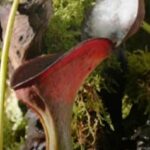As an Amazon Associate, this site earns commissions from qualifying purchases. For more details, click here.
Whether it is sarracenia or nepenthes, the most striking feature of pitcher plants is without doubt their pitcher or trap. These contraptions have evolved to serve these carnivorous plants well, but are they indispensable? Can pitcher plants survive without them? These are the questions that will be discussed in-depth in this article.
Pitcher plants feed on insects and other bugs to extract vital nutrients like nitrogen. These plants rely on pitchers to lure, trap and eat prey, so they are essential for development, growth and resistance to disease.
Why Pitcher Plants Have Pitchers
Pitcher plants grow in highly acidic soil which lack nitrogen and other needed elements. So these plants developed pitchers and became carnivores as it is the only way they can get nutrients.
Pitcher features and properties vary among species, but they have the same purpose. The interior walls are slippery to make escape difficult for prey. The ribbed opening also makes it easier to trap a prey and the lid above the pitcher blocks any trapped bug inside.
Aside from trapping , the lid also hides the pitcher mouth from approaching insects. They come in various colors which can lure bugs, but the main bait is nectar. When an insect gets onto the plant, it will fall into the pitcher due to the wet surface. If the prey lands on the lid, it can slip into the opening below.
Nepenthes and sarracenia plants developed pitchers for a specific reason, to catch prey. All plants need nitrogen and carnivorous plants are not exempted. The bottom line is that pitchers are there for a reason and are needed. If you are going to feed nepenthes with Ranz Dried Mealworms for instance, the plant will use the same process to digest the food.
Pitchers have a limited lifespan just like any other leaf. When a pitcher reaches the end of its life, it is discarded and a new one takes its place. Sometimes a pitcher might die if it tries to eat a large prey. This will not harm the plant as it will be replaced by a new one. And if the plant manages to extract nutrients before the pitcher expires that is even better.
The Benefits of Pitchers
Sarracenia and nepenthes use a lot of energy to create pitchers because they are vital. These plants will die if grown in rich soil so they depend entirely on these traps for nutrition.
If an insect falls inside one of the pitchers, the plant releases digestive fluids (in nepenthes plants this is called nepenthesin). The pitchers also contain phytotelmata, liquids meant to keep prey from getting out. These pitchers also have aldehyde crystals and scales so bugs cannot crawl up.
Pitchers not only provide nutrients for the plants, but they also serve as home for various animals. Though they are carnivorous, sarracenia and nepenthes have symbiotic relationships with various creatures such as diving ants, and assorted insect larvae.
Pitcher plants usually prey on crawling bugs, but if you hang your nepenthes they will feast on flying insects. In the wild, pitcher plants may catch small frogs and mice but they generally stick to smaller prey.
The liquids drown the animal and its tissues are dissolved by digestive enzymes or insect larvae. After the animal is eaten, the plant turns it into a soup consisting of urea, ammonium, amino acids and other elements. The pitcher plant extracts phosphorus, nitrogen and other elements from this solution.
What Happens if There are No More Pitchers?
There is a debate on just how vital nutrients are to pitcher plants that get enough light to produce glucose. What cannot be questioned is nutrients provide several benefits and they are better off having them.
Insects provide the best source of nutrients for nepenthes, and they can only be digested through pitchers. Take away these traps and there is no way for nepenthes and sarracenia to get them.
It is true pitcher plants can make food. Using photosynthesis, a pitcher plant is able to produce glucose. Like animals, pitcher plants utilize glucose as energy to perform every day functions like creating leaves, pitchers, nectar and so on.
But your plant becomes even healthier when they are given nutrients. The combination of nutrients and food enables pitcher plants to do more without losing energy.
While making pitchers require plenty of energy, you can still let the plant bloom. Flowering does not weaken pitcher plants so there is no reason to stop it. The only exception is if the plant does not get enough nutrients and sunlight.
Nitrogen is critical for all plants, even the carnivorous ones. Pitcher plants exert a lot of effort to make pitchers because the payoff is huge. Think of how much humans benefit from a healthy diet and supplements. Even though plants have no digestive systems, they also gain from consuming food and nutrients.
Why are the Pitchers on Pitcher Plants Turning Brown?
Healthy pitchers have vibrant colors, so if it starts turning brown that can be alarming. Here are the top reasons why this can could be happening.
Age. Pitchers are leaves, and just like any they turn brown with age. Brown leaves are also common in sarracenia during fall as the plant prepares for dormancy. This is not a cause for worry as it happens naturally. But if new pitchers have turned brown and it is out of season, there may be other reasons.
Not enough moisture. Pitcher plants need light but they also prefer high humidity. In a dry, arid environment, the leaves will lose their color and luster. Prolonged exposure to high humidity will dry out the liquids in the pitchers as well.
Soil is drying out. Pitcher plants will not live on dry soil. They cannot last in very wet soil either so proper moisture is key. Pay close attention to the moisture level during summer as it can dry out quickly. Some species like sarracenia need more water than nepenthes. Be careful though so as not to over water the plant and cause root rot.
Too hot. Pitcher plants need light, but too much intensity can cause leaves to overheat. As the temperature rises, water and other liquids evaporate. This will leave the pitcher dry so you have to keep the moisture and humidity up. For more information, here is a guide on why pitchers turn brown and how to fix it.
How to Keep Pitchers Growing
If you grow your pitcher plant properly, healthy traps will follow. Similarly, a struggling plant will not have the resources required to make them.
Know what pitcher plant you have. There are 8 species of sarracenia and over 100 species of nepenthes. This does not include hybrids, so there are literally scores to choose from.
Each species is native to a particular location, so you should get a pitcher plant that grows well in your area. These are sensitive to changes in their habitat, and carnivorous plants are no different. So if you want to make it easy for your plant – and yourself – get a variant that grows naturally in your region.
Nepenthes are usually grown indoors because they are tropical. Keep them in the same environment all year round and you should see plenty of pitchers. These plants are well suited for a terrarium like the one from Deco Glass. Sarracenia however, go dormant in winter so they are adapted to the outdoors.
Do not fill the pitchers with water. This will wash away the digestive liquids and could drown the bacteria and animals residing in it. They help the plant catch prey and digest food so losing them will hurt the plant. The fact there is a lid to keep rainwater out is proof these should not be filled.
Do not stuff the pitcher with bugs. A couple of these every two weeks is enough for most species. A few insects will last these plants a long time.
Conclusion
Even though pitcher plants may survive without eating bugs, they are better off getting those nutrients. For these reasons, pitchers are vital to these carnivorous plants. If you see insects inside those pitchers, you can be certain your plant is getting essential nutrition.

My fascination with carnivorous plants began many, many years ago with Venus Fly Traps. Now I am more than happy to impart what I know with other enthusiasts and those who are curious about meat eating plants.



